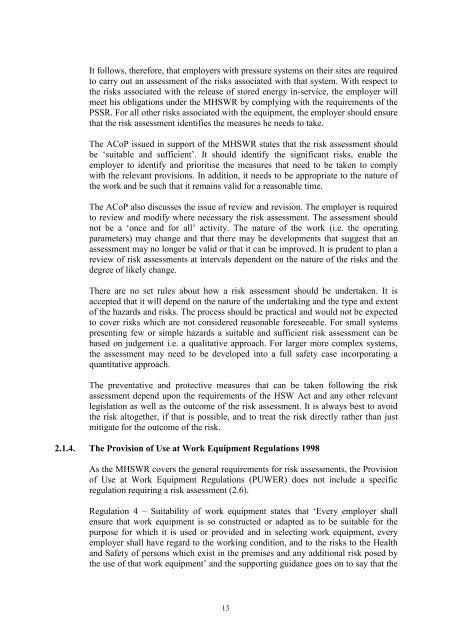Best Practice for Risk Based Inspection
risk based inspection
risk based inspection
Create successful ePaper yourself
Turn your PDF publications into a flip-book with our unique Google optimized e-Paper software.
It follows, there<strong>for</strong>e, that employers with pressure systems on their sites are required<br />
to carry out an assessment of the risks associated with that system. With respect to<br />
the risks associated with the release of stored energy in-service, the employer will<br />
meet his obligations under the MHSWR by complying with the requirements of the<br />
PSSR. For all other risks associated with the equipment, the employer should ensure<br />
that the risk assessment identifies the measures he needs to take.<br />
The ACoP issued in support of the MHSWR states that the risk assessment should<br />
be ‘suitable and sufficient’. It should identify the significant risks, enable the<br />
employer to identify and prioritise the measures that need to be taken to comply<br />
with the relevant provisions. In addition, it needs to be appropriate to the nature of<br />
the work and be such that it remains valid <strong>for</strong> a reasonable time.<br />
The ACoP also discusses the issue of review and revision. The employer is required<br />
to review and modify where necessary the risk assessment. The assessment should<br />
not be a ‘once and <strong>for</strong> all’ activity. The nature of the work (i.e. the operating<br />
parameters) may change and that there may be developments that suggest that an<br />
assessment may no longer be valid or that it can be improved. It is prudent to plan a<br />
review of risk assessments at intervals dependent on the nature of the risks and the<br />
degree of likely change.<br />
There are no set rules about how a risk assessment should be undertaken. It is<br />
accepted that it will depend on the nature of the undertaking and the type and extent<br />
of the hazards and risks. The process should be practical and would not be expected<br />
to cover risks which are not considered reasonable <strong>for</strong>eseeable. For small systems<br />
presenting few or simple hazards a suitable and sufficient risk assessment can be<br />
based on judgement i.e. a qualitative approach. For larger more complex systems,<br />
the assessment may need to be developed into a full safety case incorporating a<br />
quantitative approach.<br />
The preventative and protective measures that can be taken following the risk<br />
assessment depend upon the requirements of the HSW Act and any other relevant<br />
legislation as well as the outcome of the risk assessment. It is always best to avoid<br />
the risk altogether, if that is possible, and to treat the risk directly rather than just<br />
mitigate <strong>for</strong> the outcome of the risk.<br />
2.1.4. The Provision of Use at Work Equipment Regulations 1998<br />
As the MHSWR covers the general requirements <strong>for</strong> risk assessments, the Provision<br />
of Use at Work Equipment Regulations (PUWER) does not include a specific<br />
regulation requiring a risk assessment (2.6).<br />
Regulation 4 – Suitability of work equipment states that ‘Every employer shall<br />
ensure that work equipment is so constructed or adapted as to be suitable <strong>for</strong> the<br />
purpose <strong>for</strong> which it is used or provided and in selecting work equipment, every<br />
employer shall have regard to the working condition, and to the risks to the Health<br />
and Safety of persons which exist in the premises and any additional risk posed by<br />
the use of that work equipment’ and the supporting guidance goes on to say that the<br />
13



